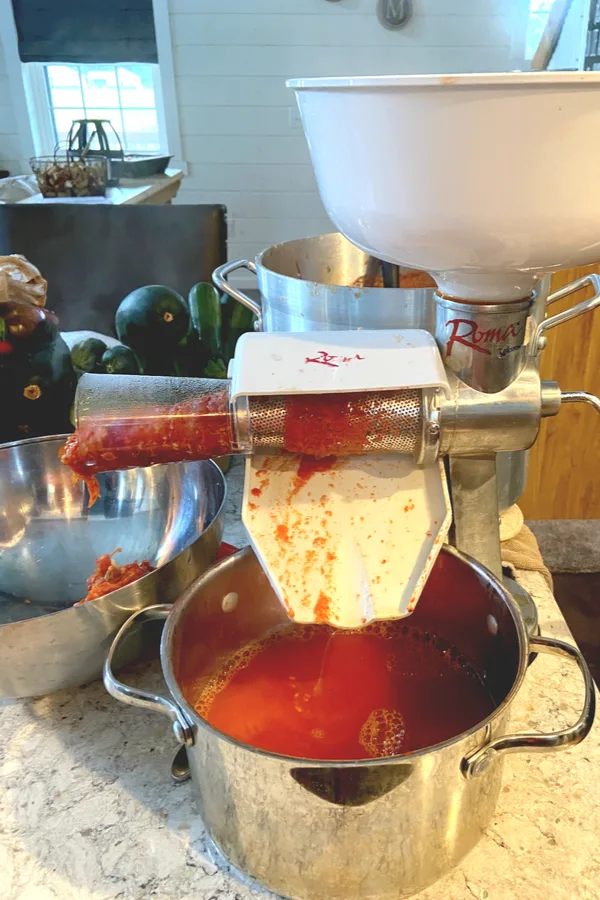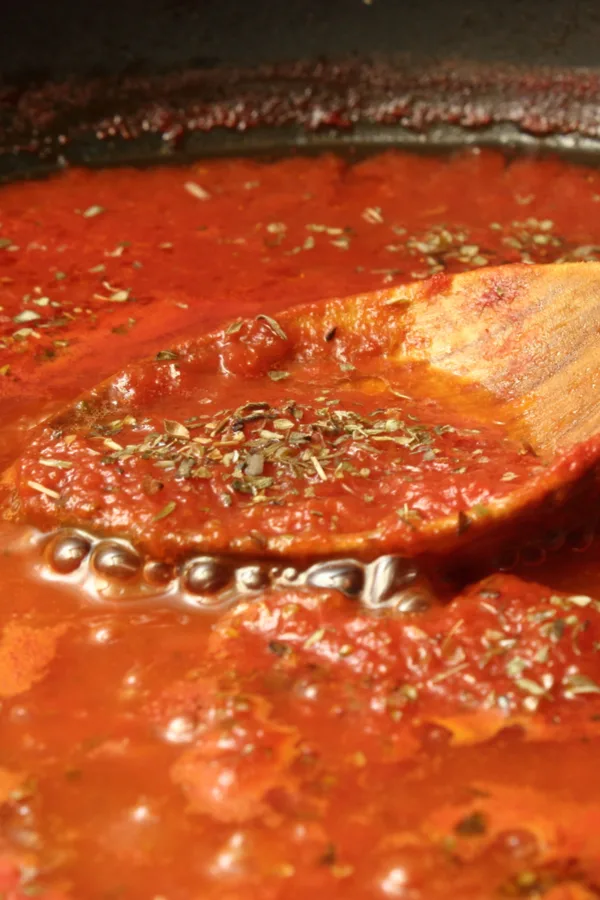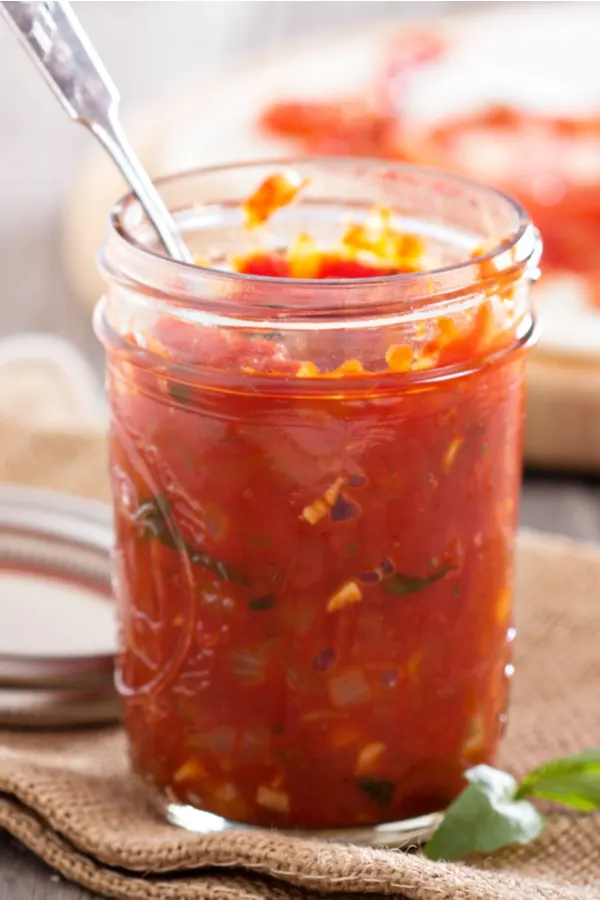Homemade Pizza Sauce Recipe
Every year when the tomatoes in our garden begin to ripen I get so excited. Not only do we have delicious tomatoes to eat, but it is also time to pull out all of our favorite tomato recipes for canning or freezing.
And when it is no longer garden season and the weather turns cool, it is nice to see our canning pantry full of all of our canned goods made from the produce out of our garden.
It is stocked full of tomato juice, salsa, diced tomatoes, tomato sauce, tomato jam, barbecue sauce, homemade ketchup and even our famous Bloody Mary mix that we use throughout the year.
But one of my favorite things to make is our homemade pizza sauce recipe.
We use it not only for pizza, but in many other recipes. We add it as the sauce for our pizza casserole, pizza spaghetti, as a dip for bread sticks, inside our pepperoni pizza rolls and calzones.
It is great to have a few jars in the pantry for a last-minute or busy weeknight meal. Boil some noodles, add in some sauce, pepperoni and cheese and bake it for a quick weeknight pizza casserole dinner.
Or how about making homemade pizza on the grill? It is a great way to enjoy pizza without heating up the kitchen. Our grilled pizza dough recipe has become a favorite among many readers.
Tomato Strainer
And it is so easy making our homemade pizza sauce recipe using our Tomato Strainer. We would be lost without it! It saves us so much time and effort when preparing our garden tomatoes for canning.
It removes the peels and seeds and leaves you with only the pulp necessary for the recipe.
Of course, if you don’t have a food strainer, you can peel and remove the seeds using the blanching process. Just place your tomatoes in boiling water for 1 minute and then immediately place them in an ice water bath.
As soon as they are cool enough to handle the skins will peel off easily!
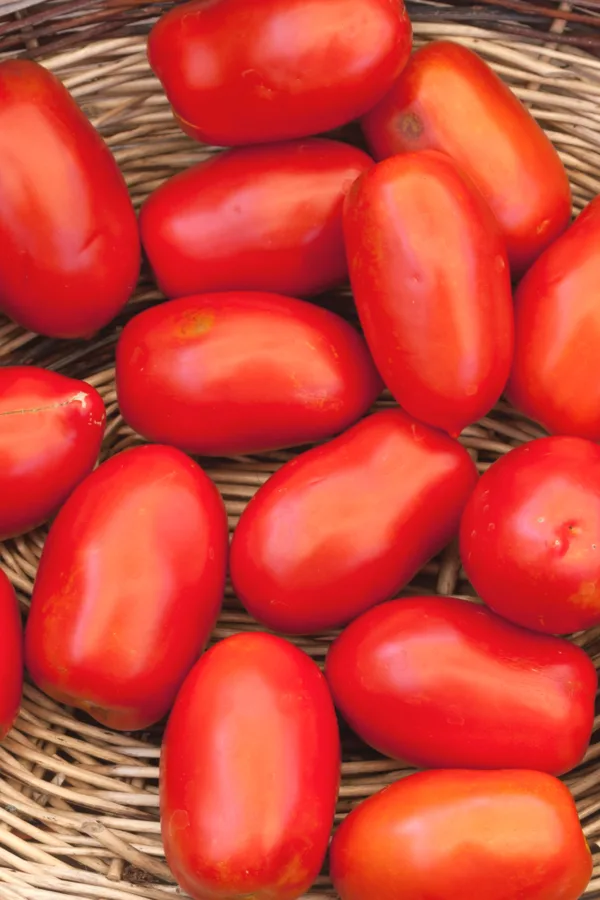
What Type of Tomatoes Make The Best Pizza Sauce?
It is best to use paste tomatoes when making pizza sauce. The thick walls of paste tomatoes will make for a nice and thick sauce.
We love our San Marzano tomatoes, but you could also use Roma or Amish paste tomatoes as well. In fact, we usually end up using all three in a single batch because we use whatever is ripe at the time.
Although if you have a variety of slicing tomatoes, you can use them as well. However, you will need to allow for extra time for the sauce to thicken. Just be sure not to use low-acid tomatoes if you plan on canning the sauce.
But no matter what tomatoes that you use, the key to this homemade pizza sauce recipe is patience. You must let the sauce simmer for an hour or more to reduce down to the traditional thickness of pizza sauce.
But believe me, it is totally worth the time!
Homemade Pizza Sauce Recipe From Fresh Tomatoes
*Complete recipe instructions including specific measurements, cook temperatures and times are located in a printable recipe card at the bottom of this article. However, be sure to keep reading for helpful tips and tricks when making this recipe.
*Makes 8-9 pints
INGREDIENTS:
- Paste tomatoes
- Dried oregano
- Kosher Salt
- Fresh ground black pepper
- Garlic powder
- Bottled Lemon Juice
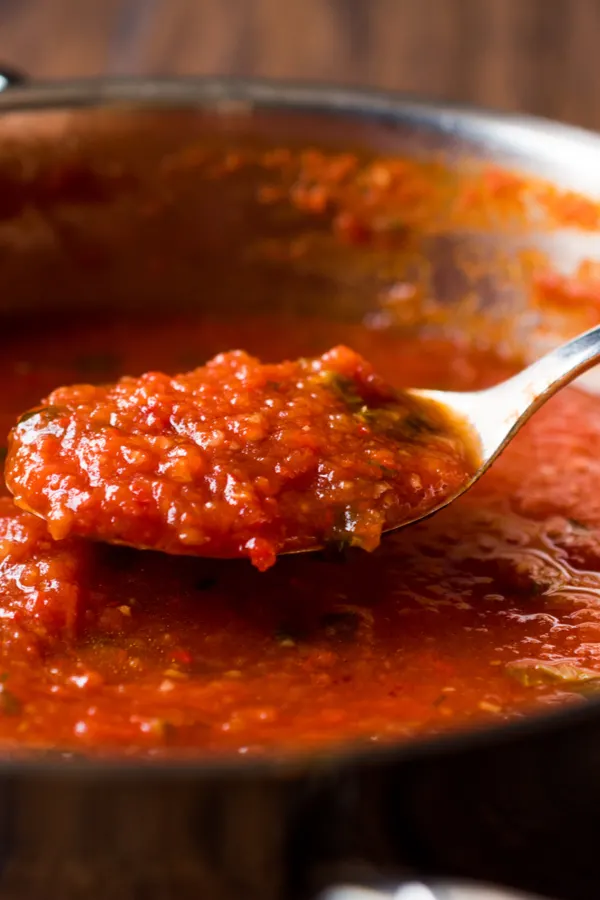
INSTRUCTIONS:
The first step in making Homemade Pizza Sauce is to wash the tomatoes and remove the core and any bad spots.
If you don’t have a tomato strainer, you will need to remove the skins by hand. Do this by placing the tomatoes in boiling water for 1 minute, working in batches as needed.
Then immediately remove tomatoes and submerge them in an ice water bath for one minute. Remove them from the water and set aside until cool enough to handle.
Next, make a small slit on the surface of the tomato and remove the skin. At this point it should peel off easily.
Then cut the tomato in half and remove and discard the seed core. Dice the tomatoes into large chunks and place in a food processor or blender, working in batches if needed.
We have a Hamilton Beach 12 cup food processor that can hold a lot of tomatoes. However, if your food processor is on the small side, it would be best to use a blender.
Once the tomatoes have been pureed pour them into a large stockpot. Then proceed to the cooking instructions below.
Tomato Strainer Instructions
However if you have a tomato strainer the steps to remove the skins and seeds are a little different. Start by dicing the tomatoes into large chunks.
Then place them in a large stockpot over medium heat and bring to a light simmer, stirring frequently so that the tomatoes on the bottom don’t stick or burn.
Once the tomatoes have been heated enough to soften slightly, place them in the food strainer with the salsa or pizza sauce attachment.
The strainer will discard the seeds and skin and leave you with the pulp required to make homemade pizza sauce.
Cooking Instructions
After you add the tomato pulp/puree to a large stockpot, it is time to add the seasoning to the homemade pizza sauce.
Add the oregano, salt, pepper and garlic powder to the pot and stir well until incorporated. Then keep the pot over medium heat and bring the mixture to a boil, stirring frequently.
Once boiling, reduce the heat and simmer until the sauce reduces by about half. If you used all paste tomatoes, this process will take about 90 minutes.
However, if the majority of your tomatoes are slicing tomatoes then it will take an additional 60-90 minutes for the sauce to thicken.
Be sure to keep a close eye on the pot while the mixture cooks down. You will need to stir the pot frequently, being sure to scrape the bottom of the pot so that the tomatoes don’t stick and burn.
Once the homemade pizza sauce has reduced and thickened to your liking, it is time to prepare it for freezing or canning.
Freezing Instructions
If you plan on freezing the pizza sauce you will not need to add the bottled lemon juice to the mixture. The lemon juice is only required when canning.
Before freezing, remove the pot from the heat and let the mixture cool completely. Then freeze in air-tight, pint-size freezer containers.
Whenever freezing sauces be sure to leave 1/2 inch headspace to allow for expansion during the freezing process.
Store in the freezer for up to 12 months.
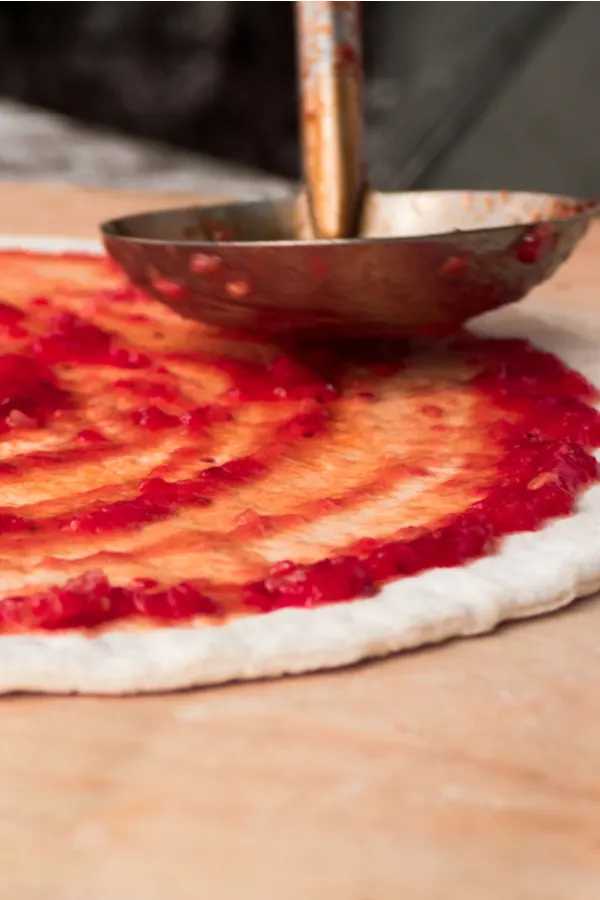
Canning Instructions
If you plan on canning the homemade pizza sauce sterilize pint size canning jars while the mixture is thickening.
Then fill your water bath canner with enough water to be 1-2 inches above the canning jars.
When you are ready to can the sauce, pour 1 tablespoon of bottled lemon juice to each jar. Then ladle the sauce into each jar, leaving 1/4″ headspace.
Wipe the rim clean and place the lid on top. If you are using Sure-Tight canning lids, no heating of the lid is required.
Next, add the rings and tighten to finger-tight only. Use jar lifters to place the jars in the water bath canner, being sure that the water is 1-2 inches above the tops of the jars.
Bring the water to a rolling boil and then set a timer for 35 minutes, adjusting for altitude as needed.
Once the timer goes off, turn the heat off and let the jars in the hot water for 5 minutes. Then carefully remove the jars from canner and place onto a thick towel and let cool for 24 hours.
Before storing make sure the lids have properly sealed by pressing on the center of the lid. If the lid does not move up and down, the homemade pizza sauce is safe to store on a shelf in a cool, dark place.
However, if a jar did not seal properly, place it in the refrigerator and use within 2 weeks.
Small Batch Pizza Sauce Recipe
If you are looking for a great way to make pizza sauce in a smaller batch, be sure to check out our favorite Instant Pot Pizza Sauce recipe.
It uses a pressure cooker to make the sauce instead of boiling it on the stove. And the taste is just as good!
Enjoy!
Mary and Jim

To receive our 3 Home, Garden, Recipe and Simple Life articles each week, sign up below for our free email list. You can also follow us on Facebook, Twitter, Pinterest, or Instagram. This article may contain affiliate links.

Homemade Pizza Sauce - Made From Fresh Tomatoes
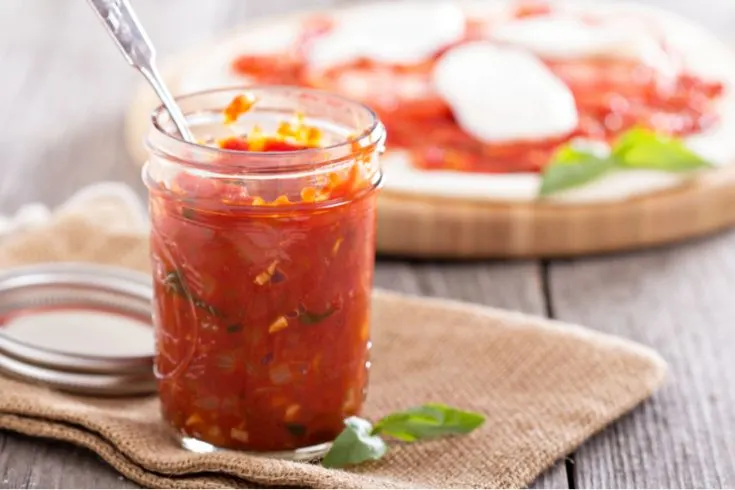
Ingredients
- 20 pounds paste tomatoes (Roma or San Marzano)
- 4 tsp dried oregano
- 2 tsp freshly ground black pepper
- 2 tsp salt
- 2 tsp garlic powder
- 1 T lemon juice per pint jar
Instructions
- Wash tomatoes and remove any bad spots and the core.
- Bring a large pot of water to a boil and place a few tomatoes in at a time and boil for 1 minute. Immediately remove the tomatoes with a slotted spoon to a bowl of ice water to stop the cooking process. Slice each tomato in half. Remove the skins and seeds and discard. Place the peeled and seeded tomatoes in a food processor or blender. Puree and then place in a large stockpot
Tomato Strainer Instructions
- Cut tomatoes in large chunks and place in a large stockpot over medium heat. Bring to a simmer and then pour through your food strainer to remove the seeds and skins. Add the pulp to a clean, large stockpot.
- Add oregano, pepper, salt, and garlic powder and stir well.
- Over medium heat, bring mixture to a boil, stirring frequently.
- Once boiling, reduce heat and simmer for 60-90 minutes without a lid, stirring frequently until the sauce reduces by about half.
Freezer Instructions
- Let the pizza sauce cool completely and freeze in pint size freezer containers leaving 1/2 inch headspace for expansion.
Canning Instructions
- While the pizza sauce is hot, add 1 tablespoon of lemon juice to each sterilized pint jar. Pour the hot pizza sauce into the jars, leaving 1/4″ of headspace. Wipe the rims clean and place the lid on each jar. Add the rings until finger-tight. Place in a hot water bath, being sure the water is 1-2 inches above the lids. Once the water is at a rolling boil set timer for 35 minutes, adjusting for altitude as needed.
- Once the timer is up, turn off the heat and let the jars sit in the hot water for 5 minutes. Remove jars from canner onto a thick towel and let cool for 24 hours. Make sure lids have sealed and store in a dark cool place.
Notes
Recipe courtesy of Old World Garden Farms
Nutrition Information:
Yield:
9 pintsAmount Per Serving: Calories: 187Total Fat: 2gSaturated Fat: 0gTrans Fat: 0gUnsaturated Fat: 1gCholesterol: 0mgSodium: 568mgCarbohydrates: 41gFiber: 13gSugar: 27gProtein: 9g
Nutritional Information is to be used as a general guideline only . Nutritional calculations will vary from the types and brands of the products used.


